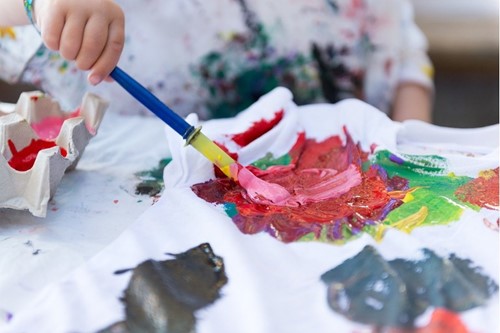How to Encourage Creativity in Your Toddler
Creativity is a vital skill for children to develop as they grow. Creative thinking allows kids to problem solve, express themselves, and tap into their imaginations. As a parent, you can start nurturing creativity in your toddler through everyday play and activities. With some simple ideas, you’ll set your little one up to thrive both academically and socially down the road.

Provide Open-Ended Toys
Toys that can be used in multiple ways with no clear instructions spark creative thinking in young children. Simple household items like wooden spoons, empty boxes, ribbons, and stacking cups offer endless possibilities. Adobe Express has some awesome preschool activities on their blog if you need some ideas. Avoid toys that only have one function or move predictably with the push of a button. Opting for art supplies, dress-up clothes, play dough, blocks and other open-ended toys encourages kids to decide how to use materials. There’s no right or wrong so let your toddler explore freely.
Ask Imaginative Questions
Engage your toddler in pretend play by asking questions that spark their imagination. If they’re crawling through a cardboard box “spaceship”, you might ask where they’re headed or what planet they hope to visit. Avoid questions with simple yes/no answers. Phrases like “I wonder what you’ll see out the spaceship window” fuel the storyline your little one creates. Descriptive language is key when playing make-believe with your child, so feel free to dive in with your own ideas too.
Inspire Creation over Perfection
When providing art supplies like crayons, markers, paint and play dough, keep the focus on your toddler’s experience over the end product. Refrain from judging creations as good or bad. Instead, comment on the colours they used, ask what their art represents or display it proudly on the fridge. Let them freely experiment with mixing paint, combining play dough colours and testing out writing tools without worrying about neatness. The goal is to nurture creative confidence, not perfectionism. Embrace the mess!
Rotate Toys and Art Materials
While toddlers love routine, introducing novel items alongside familiar toys sparks fresh inspiration. Rotate books, art supplies, dress-up clothes, and other engaging materials so your child has a mix of beloved standbys and new things to discover. You might stash certain toys away for a month then reintroduce them. Or check out board books from the library on different topics. New-to-them toys present new ways to imagine and create.
Encourage Problem Solving
When your toddler faces a challenge, avoid jumping in too quickly to help. If they’re having trouble connecting train track pieces or reaching a toy on a shelf, wait and give them a chance to solve it independently. You might offer verbal suggestions but let them attempt carrying out the actions. Successful problem-solving builds creative confidence and resilience. Of course, provide help if they’re truly struggling or becoming upset. But pause before intervening so your toddler can exercise their own resourcefulness.
Inspire with Varied Experiences
Exposing your toddler to a range of real-world places, textures, sights and sounds fuels a sense of wonder that manifests itself in imaginative play. Visit museums, gardens, beaches and other locations that offer hands-on exploration. Play with materials like sand, snow, pinecones and seashells. Provide musical instruments like rain sticks, maracas and bells to discover. The more diverse experiences your child has, the more these impressions will emerge in their pretend play and creations. Their creativity mirrors the world you show them.
Use Media Thoughtfully
While apps and educational shows have their place, don’t let too much media stifle your toddler’s original ideas. Set limits on using tablets or watching certain programs so your child has plenty of time for unplugged play and interaction with you. When introducing apps and shows meant to teach concepts, stay engaged by asking your toddler open-ended questions afterwards like “I wonder what else we could build with blocks?” This encourages them to take what they learned on-screen and apply creativity to hands-on play.
Model Creative Thinking
From how you put together meals to how you solve everyday problems, your toddler observes and learns from your creative approaches. Narrate your process as you’re prepping an improvised dinner, fixing a wobbly chair or brainstorming party ideas. Use descriptive words to convey your mental process. Seeing and hearing you work through steps gives your toddler great creative role modelling. No need to overthink this one – just let them watch you think out loud!
The early toddler years set the stage for lifelong creative habits. Follow these guidelines day-to-day and watch your child’s imagination flourish! Their innate creativity will blossom as you give them freedom in play and engage their sense of wonder with new experiences.